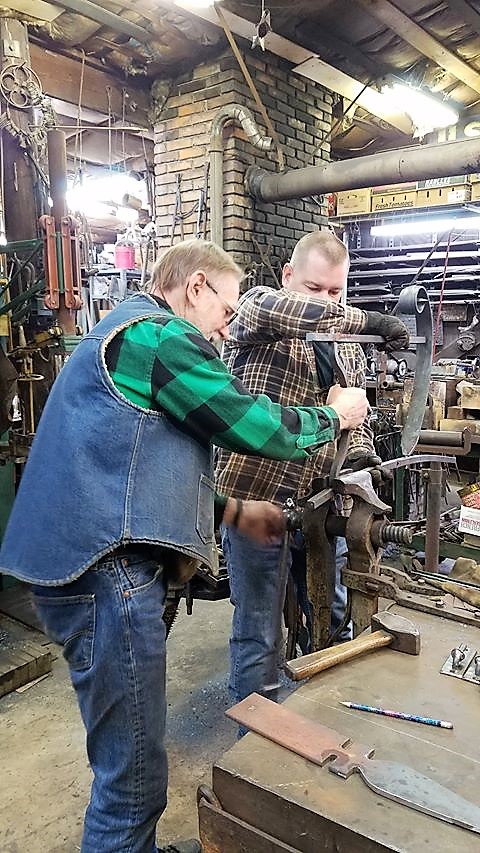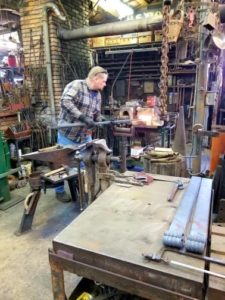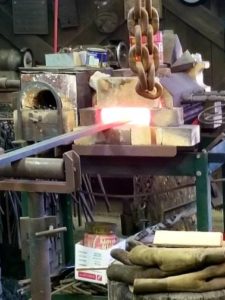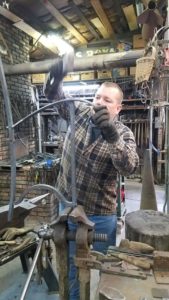2019 TRADITIONAL ARTS APPRENTICESHIP PROGRAM: PAT McCARTY WITH MATT DICKSON
It’s time to roll out another profile of a 2019 Traditional Arts Apprenticeship Program team.

Master blacksmith Pat McCarty (left) and apprentice Matt Dickson (right) work on joinery at McCarty’s Washington Forge. Photo courtesy of Pat McCarty
Coal, copper, and steel. These are the basic materials that master blacksmith Pat McCarty and his most recent apprentice Matt Dickson require when they meet for eight hour sessions at Washington Forge. With those materials, Matt practices joinery and hammer control, riveting and fastening, heating and veining. With those materials, techniques, and the right tools, Pat knows that Matt can learn to complete projects that are “finished to last a lifetime.”
Pat McCarty has an extensive history of teaching the tradition of blacksmithing, from one-on-one classes at his own forge in Washington, Mo. and classes at Luxenhaus Farm in Marthasville, Mo. to co-teaching “treasure chest” workshops at the John C. Campbell Folk School in Brasstown, NC. Pat himself credits the Blacksmith Association of Missouri (BAM!), in particular, as the source of his own training as a fledgling blacksmith, followed by joining the very first class at the late Tom Clark’s Ozark School of Blacksmithing in Potosi, Mo. Decades later, Pat has attained a reputation as a master blacksmith and metal artist. He is a Juried Member of Best of Missouri Hands, and he demonstrates annually by invitation at Silver Dollar City‘s fall craft festival.
Apprentice Matt Dickson is no novice blacksmith himself, with five years of experience under his belt. He tells us that he was hooked on the tradition after a basic class at the Tom Kennon Blacksmith Shop in Doniphan, Mo. He quickly joined BAM, as well as the Artist Blacksmith Association of North America, attending “all the meetings I could get to.” Matt says he would watch, ask questions, and “then go home and try it myself.” In addition to Pat McCarty and Chis Miller of the Doniphan shop, Matt credits previous Traditional Arts Apprenticeship Program master artists Bob Alexander, of Scrub Oak Forge in DeSoto, and Bernie Tappel, of Osage Bluff Blacksmith Shop outside of Jefferson City, as key influences.
Matt says of Pat: “I feel he is the most committed smith I have ever met. He always takes the time to explain not only what he is doing, but also why he is doing it this way. Pat has showed me the importance of passing this craft along and learning traditional techniques. He shows great planning skills, tool making skills, and is a great role model for this craft.”
Matt himself is a committed blacksmith; he says: “I practice this craft daily in my shop after working my full-time job. I spend my time making camping cook sets, spatulas, fire pokers, hinges, bells and have made metal flower sculptures.” He recently demonstrated at his first public event–the Kimmswick Apple Butter Festival, and it looks like he intends to make blacksmithing a family tradition, as he wants to his kids to make “their own camp tools for roasting their marshmallows.”
During this apprenticeship, Matt is making a patio bench for his home. Click on photos in the gallery below to see a bit of the process.
-

- Dickson heats a piece of metal before working it into his patio bench. Photo courtesy of Pat McCarty
-

- Dickson heats a piece of metal before working it into his patio bench. Photo courtesy of Pat McCarty
Come to the historic Lohman Building the afternoon of Saturday, June 15, 2019 for an outdoor blacksmith “hammer-in.” The Missouri Folk Arts Program and Missouri State Museum will co-host three Missouri blacksmith teams, who will demonstrate a variety of techniques using coal forges, anvils, and handmade tools.
Join Pat McCarty and Matt Dickson, along with Bob Alexander and apprentice Lisa Thompson and Ray Joe Hastings with his apprentice Keith Whiteside for this special event.
The heart of Missouri Folk Arts Program is its Traditional Arts Apprenticeship Program. Master artists work one-on-one with apprentices to keep folk arts knowledge and practices alive. In Missouri, with support from the National Endowment for the Arts, the Missouri Arts Council, and the University of Missouri, the first master-apprentice lesson took place on December 10, 1984. Since then, Missouri has supported over 400 apprenticeships in which 200+ master artists have mentored more than 500 apprentices in every region and many communities in the state. Many apprentices have in their turn grown in their artistry and later recognized as master artists in TAAP. They forge anew living links in the chain of Missouri’s folk arts. Some TAAP artists practice traditional regional crafts that date back to Missouri’s Native American peoples and early European settlers. Some newer immigrants, such as Latinxs, Sudanese, and Bosnians, have sustained their artistic traditions in their new homes in Missouri. Still more traditions have migrated to Missouri from other regions of the U.S. All are re-imagined and honed into dynamic Show Me State traditions. Among the arts that have been fostered in TAAP over the decades are blacksmithing, cowboy poetry, old-time short-bow fiddling, African-American storytelling, Ozark Riverways paddle carving, Vietnamese dragon dancing, Western saddle making, old-time clawhammer banjo, wood joinery, square dance calling, German bobbin lace, turkey calls, Mexican paper flowers, and Slovenian button-box accordion.
[Posted April 25, 2019 by Lisa L. Higgins]

